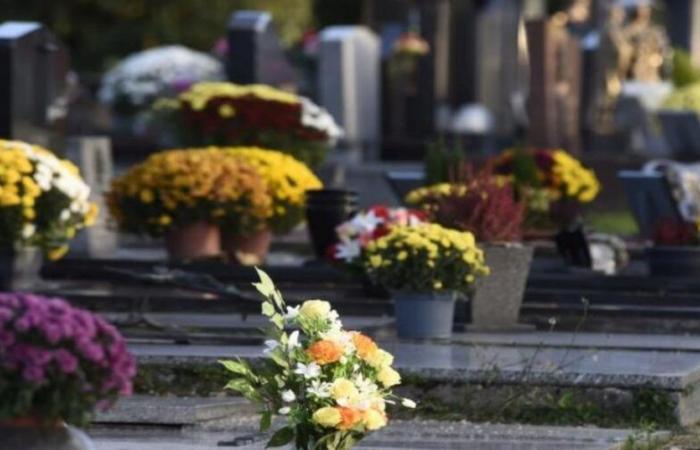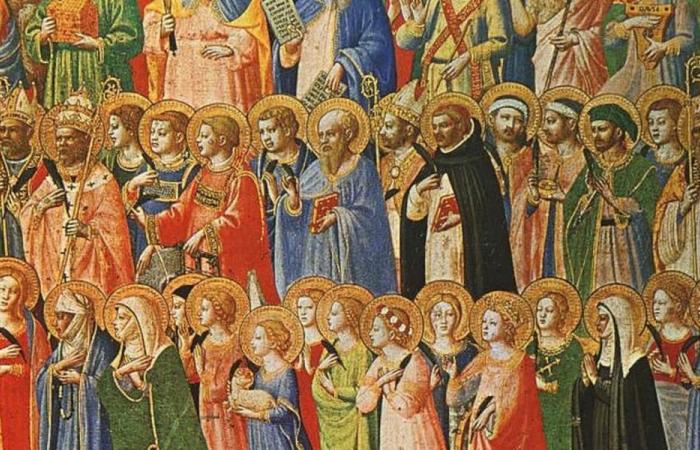All Saints’ Day is the feast of all saints in the Catholic religion. In this painting by Fra Angelico, the precursors of Christ with the saints and martyrs in 1423-1424.
Creative Commons
The hope of resurrection
Unlike most major liturgical celebrations such as Christmas, Easter or Pentecost, this religious festival does not come from biblical texts but has its origins in the 4th century in the Eastern Church, in Turkey, Syria or even Egypt. , who created it to commemorate all the martyrs. Believing that they had already joined Christ, Christians from the East then prayed for intercession on their behalf.
All Saints’ Day has long been celebrated on May 13, close to two major festivals of Easter and Pentecost.
Then, this celebration arrives in Rome and the West. Pope Boniface IV, who in 609 was offered the Pantheon of Rome, a pagan temple, in honor of all the gods, then had the bones of martyrs from the catacombs transported there and, on May 13, 610, he consecrated the Pantheon, transforming it into the church of Sainte-Marie aux Martyrs. Subsequently, the anniversary of this consecration, then called the Feast of Martyrs and All Saints, which many Christians come to attend, will be celebrated for a long time every May 13, close to the festivals of Easter and Pentecost. A link which gives it its original meaning: to already taste the joy of those who have put Christ at the center of their lives and to live in the hope of the resurrection.
Why November 1st?
Fight paganism by recovering the ancient Celtic pagan festival, the ancestor of Halloween.
Since ancient times, in pre-Christian times, the Celtic peoples of Ireland and “Great Britain” celebrated “Samain” on November 1, a festival dedicated to the dead, after the last harvests at the end of the autumn, and which corresponded to the Celtic New Year. Like most major Christian holidays, it is precisely to combat paganism by recovering this pagan festival, the ancestor of Halloween, that the Catholic Church will set up at the same time its own festival of All Saints. It was in the 8th century that Pope Gregory III set the date of All Saints’ Day on the 1st November, the day he dedicated a chapel of St. Peter’s in Rome in honor of all the saints.
Around 835, on the order of Louis the Pious, Pope Gregory IV ordered that All Saints’ Day be celebrated throughout Christendom, but it was not in the 20th century, under the pontificate of Pius X, that it entered the list of the eight Catholic holidays, with the obligation to hear mass and then becomes a non-working holiday. According to the Catholic Church, “this feast is also an opportunity to remember that all men are called to holiness, by different paths, sometimes surprising or unexpected, but all accessible”.
Day of the Dead
All Saints’ Day is a public holiday, not the Day of the Dead
All Saints’ Day and All Souls’ Day, which directly follows it and will be celebrated this Saturday, November 2, are associated, but if we tend to confuse them, their vocation is different. A joyful celebration, the feast of All Saints has testified since the 4th century to Christian hope in the face of death. All Souls’ Day was created later, in 998, by the Benedictine monastery of Cluny to celebrate the memory of all the deceased, and not just the martyrs. It was in the 13th century that the Church included in its universal calendar this day when Catholics will put flowers on the graves of their loved ones and pray for the salvation of their souls.
All Souls’ Day is not a public holiday, unlike All Saints’ Day, which since its establishment in the 9th century, has always been part of the 50 non-working days of the Catholic calendar. Suppressed during the French Revolution, to lessen the influence of the Church, the feast of All Saints was reinstated in 1802 by Napoleon. It is therefore one of the eleven public holidays listed in the Labor Code.
Elsewhere in the world
European countries such as Belgium, Luxembourg, Austria, Poland, Hungary, Italy, Spain, Portugal share this tradition – in Italy it is called “Ognissanti”, in Spain “Todos los santos.” For them, November 1 is also a public holiday, which is not the case in countries with an Orthodox religious tradition (Serbia, Russia, Greece and Romania) or Protestant (Denmark, Netherlands, Ireland, Finland, Germany , Sweden or England). In Sweden, however, it is customary to go and pray during this day to place wreaths and flowers and light candles or tapers on the graves. To do this, most Swedes take a day off.
The deceased are celebrated differently in other religions and cultures. In Mexico, for example, “el Día de los muertos” is a big celebration during which families gather around the graves of their loved ones with offerings and food, to the sound of mariachi music.
South West Archives/Xavier Léoty
Chrysanthemum sales in front of the Saint-Éloi cemetery in La Rochelle, on the occasion of All Saints’ Day weekend, October 29, 2010.







